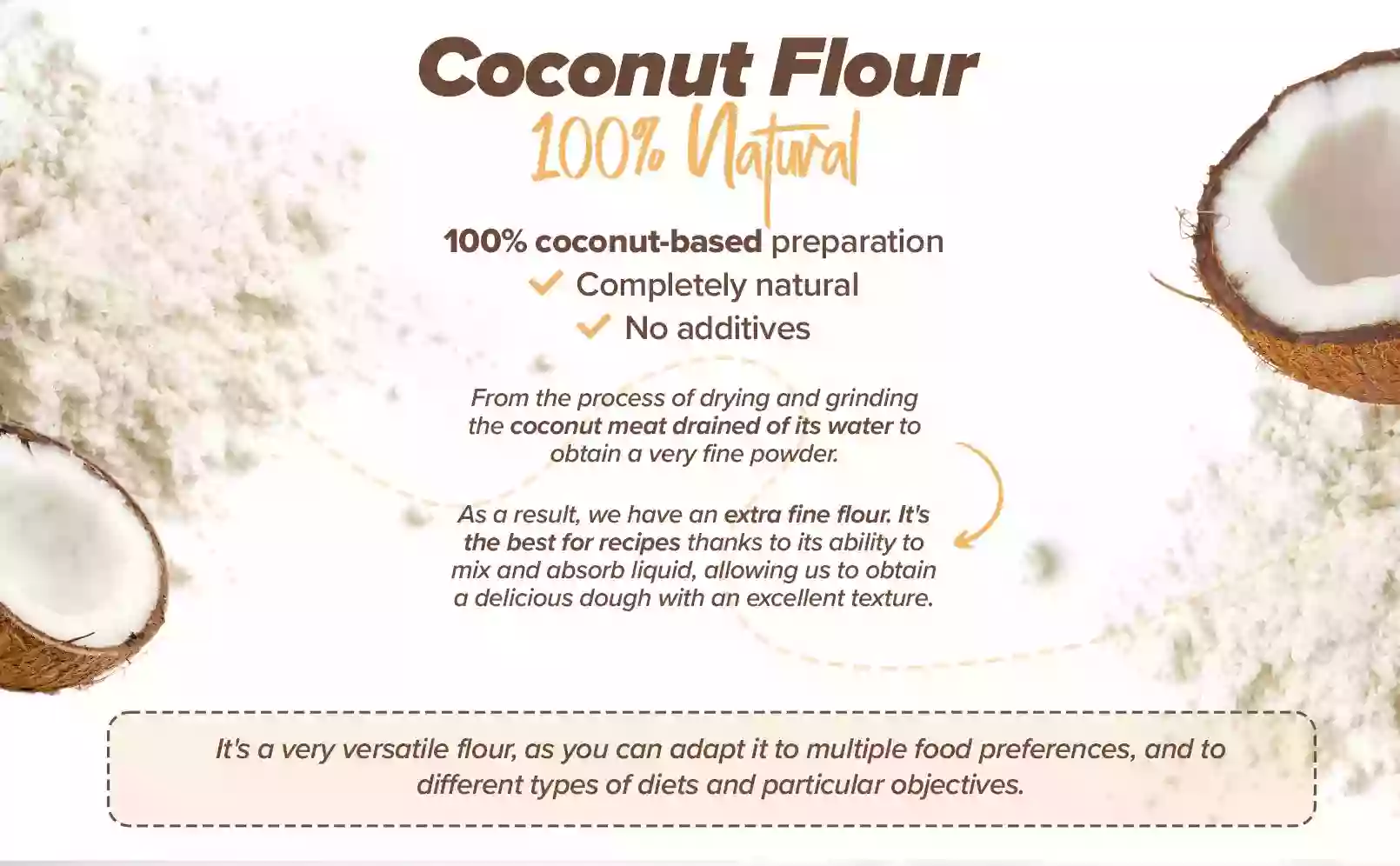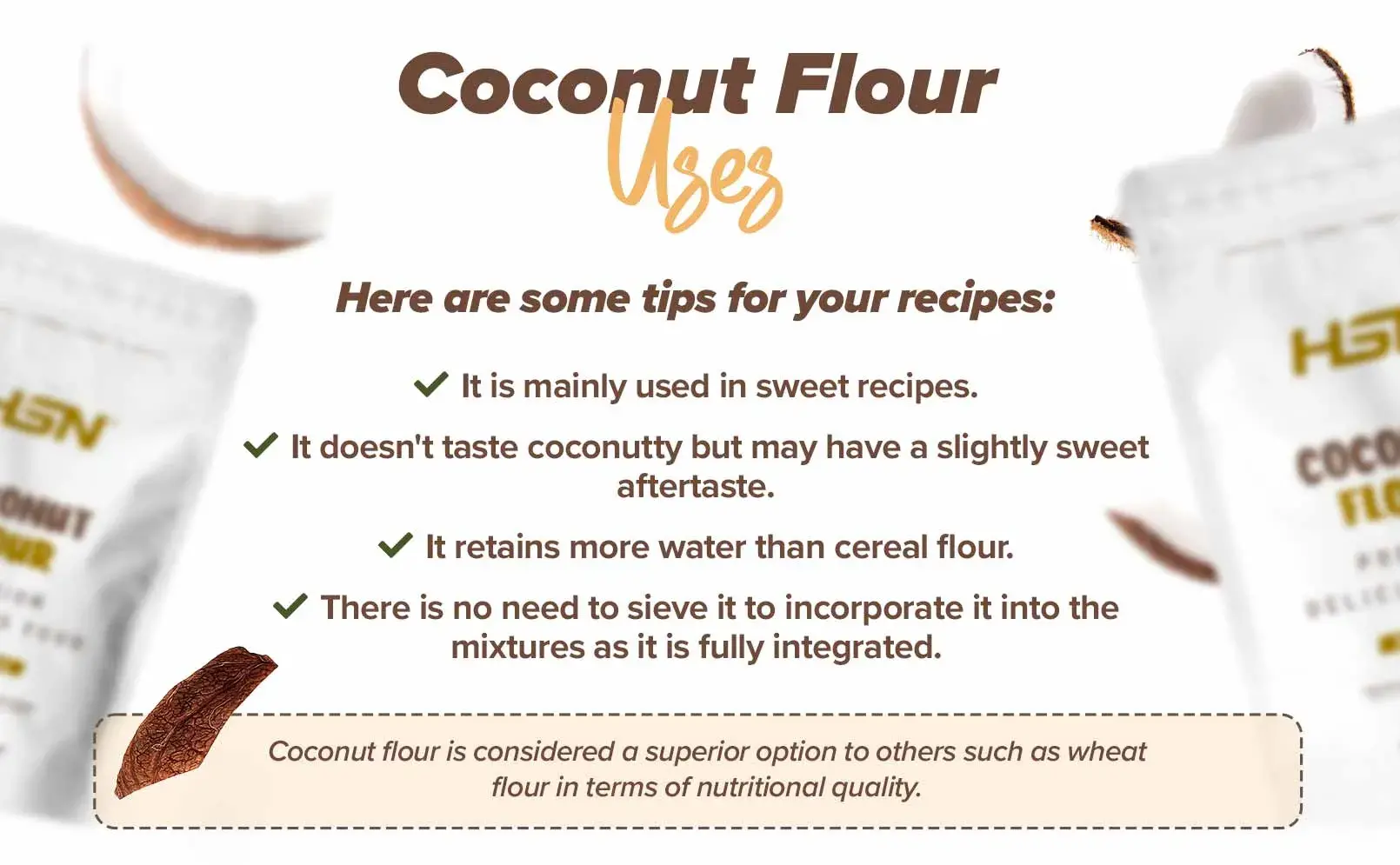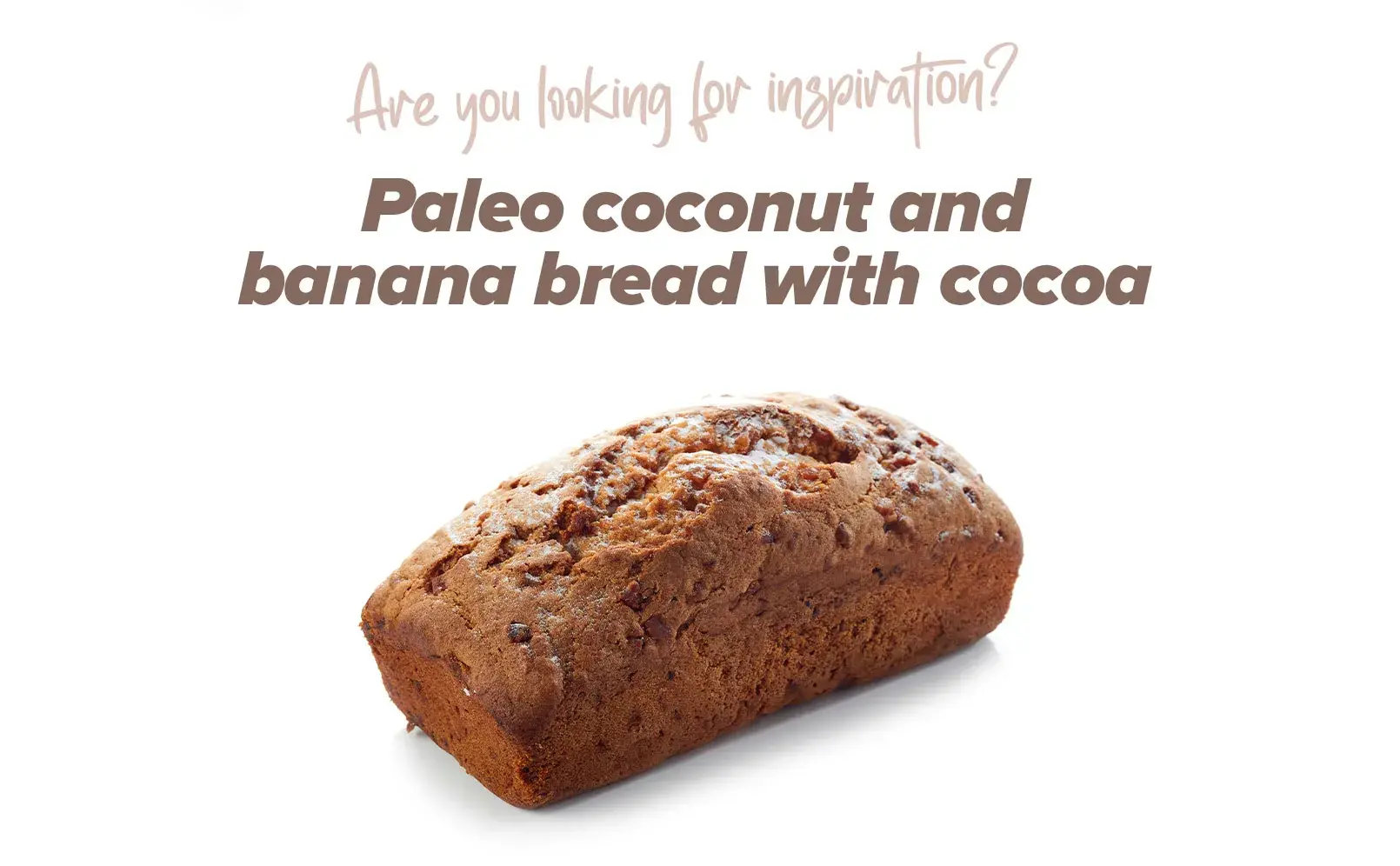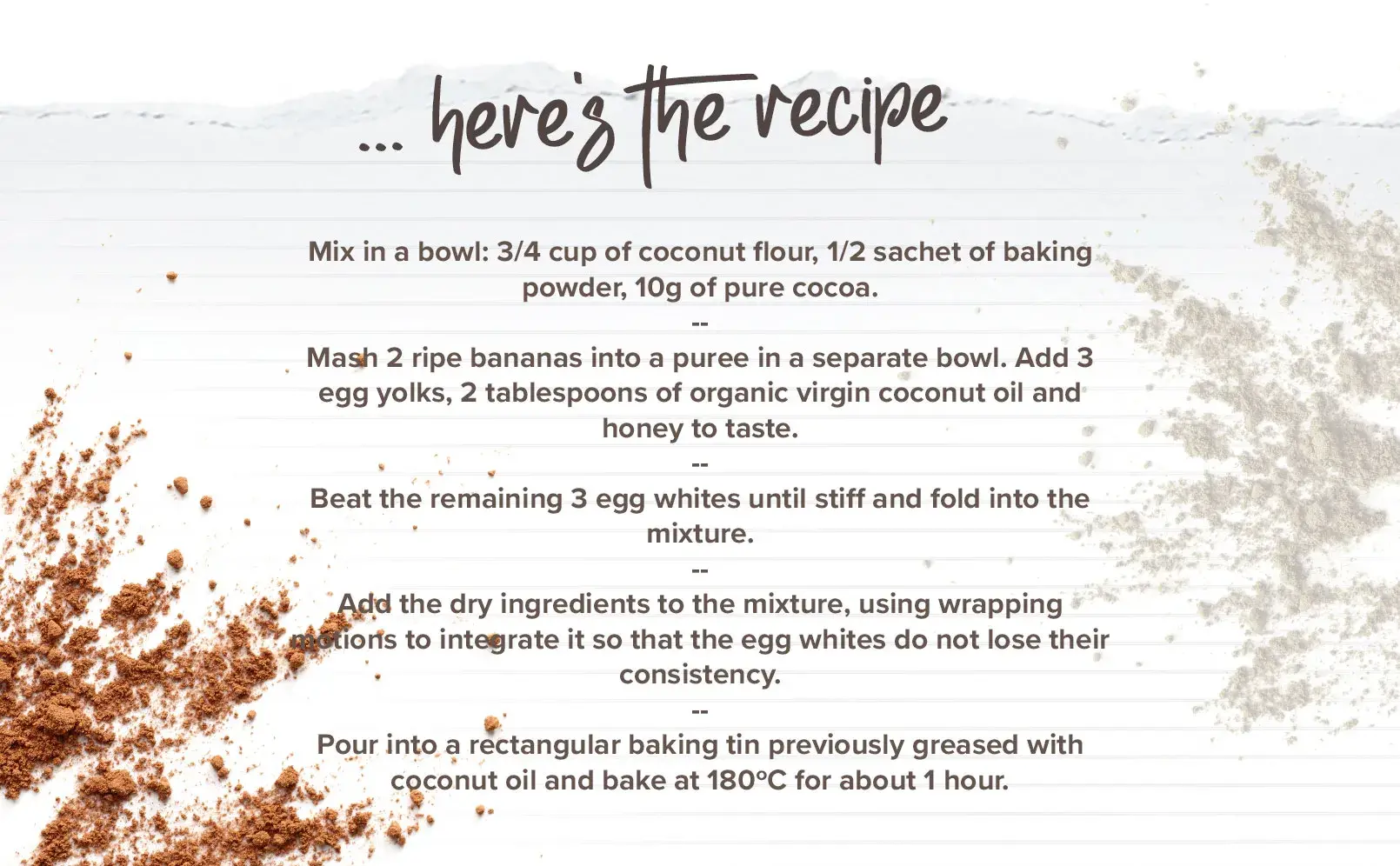- Extra fine coconut flour. For easy cooking.
- High fibre content (43%). It helps to increase fibre intake in a simple way.
- Plant-based protein source. It provides 18g/100g of product.
- Ideal for Vegan & Low-Carb diets and recipes.
- Gluten-free, suitable for coeliac and vegan diets.
- Mild flavour. It does not alter the natural taste of dishes.
- It can be used for sweet and savoury recipes. See below for ideas!
- No added sugars. Only naturally occurring sugars.
- Traditional processing, following non-industrialised methods for flour preparation.

Your new ally in the fitness kitchen!
Coconut flour by FoodSeries is a 100% coconut-based preparation, completely natural and without additives. It is generated from the drying and grinding process of the coconut meat drained of its water. This process results in a fine powder with a low percentage of moisture that looks and behaves like traditional grain flour.
Coconut flour has obvious advantages over cereal flours, such as lower calorie content, and less processing, which means it is not refined and retains a high % of the natural coconut fibre concentrated due to the loss of moisture from the 'native' coconut meat, that makes its net fibre content very high, as well as its versatility for recipes.
Don't miss out on all the properties, ideas, and benefits of coconut flour.
How is Coconut Flour made? Is it natural?
HSN uses raw materials of the highest quality to produce its products. In this case, the coconuts come from coconut plantations based on sustainable and environmentally friendly development. We absolutely rule out the use of coconuts from coconut farms that do not meet the necessary sustainability requirements in order not to harm the local flora and fauna.
The cultivated and harvested coconuts are opened by hand and their natural water is drained out and used to make other products, such as the coconut water powder contained in our Cocolytes.
The natural activated charcoal in our catalogue is prepared from coconut shells. Instead of coming from inorganic sources such as coal or pitch, it is developed from the treatment of organic elements, in this case, coconut shells.
And with the coconut meat, we already produced products like the Desiccated Coconut by FoodSeries, now also the flour:
The coconut meat used to make the flour is washed, because the aim is to reduce the natural coconut flavour in the flour so that its taste is mild and as neutral as possible. If you want a strong coconut flavour, it is preferable to use desiccated coconut, which has a natural flavouring and taste.
After washing, the coconut meat is placed in low-temperature ovens, which allows the coconut meat to gradually lose its natural water until it becomes pure coconut meat without moisture, that is, completely dry.
This dried coconut meat is ground, i.e., mechanically crushed with traditional tools, to obtain coconut flour.
At HSN we carry out further processes, which are based on 'multi-grinding', i.e., once the flour has been obtained, we sift it, and regrind those particles that do not comply with a suitable dimension to obtain an 'extra-fine' flour. It is the best for recipes thanks to its good mixing and liquid absorption capacity, making it possible to obtain a delicious dough with an excellent texture.
This is how our top-quality extra-fine coconut flour is made. At HSN, we are completely transparent with our procedures, and we want you to know about them in detail.

For whom is coconut flour suitable? In which diets can it be used?
Coconut flour, despite being called flour, does not share the nutritional characteristics of the traditional flour that we have all always used in the kitchen: cereal flour.
Instead, it is the origin of the coconut that determines the characteristics of this flour:
- It is higher in fibre.
- It contains proteins that cereal flour does not provide.
- It has fewer carbohydrates than cereal flour.
- It does not contain gluten characteristic of cereals such as oats, wheat, and barley.
It is therefore suitable for:
- Low-carb diets, even keto diets in moderate amounts.
- People with coeliac disease or gluten intolerance.
- People on carnivorous or paleo diets with low fibre intake, to provide more fibre.
It is a very versatile flour as you can see, you can adapt it to multiple food preferences, and to different types of diets or objectives.
Outstanding nutritional value of coconut flour and its properties
Coconut flour provides per 100g:
Mostly saturated, from MCT fatty acids, or medium chain triglycerides composed of C8 and C10 acid, characteristic of natural coconut.
All of them are natural coconut sugars, with nothing added, they are sugars from the native matrix of the food. Although this may sound like a lot, it really isn't, and an approximate average use of coconut flour (30g) provides 5g of carbohydrates, which is a low contribution.
A very high dietary fibre content, the daily intake of which is often suboptimal due to insufficient intake of whole grains, fruits, and vegetables by the Western population.
Plant-based and of high quality. It is ideal for enriching your sweet or savoury recipes with a considerable amount of protein.

Organoleptic characteristics to be taken into account with Coconut Flour
Coconut flour is not the same as wheat flour, rice flour or almond flour, and this means that a series of essential aspects must be considered so that the result in our recipes is optimal.
For example:
Water ratio
Coconut flour retains more water than cereal flour; if you use coconut flour in part of the recipe, we recommend that you increase the volume of water required by twice the amount of coconut flour used.
If you replace 30g of almond flour with 30g of coconut flour, and you had to add 30ml of water, now add 60ml for optimal results.
Mixing capacity
Our coconut flour is extra fine, so there is no need to sieve it to incorporate it into the mixtures, as it integrates completely.
However, due to the natural characteristics of coconut, it may require more time to work on the mixture or dough before it can be fully homogenised, as its instantaneous integration is less than that of flours that are easier to incorporate into mixtures such as refined wheat.
This is due to its higher natural fibre content which makes it more time-consuming to mix thoroughly.
Taste
Coconut flour does not taste like coconut but may have a slightly sweet aftertaste due to the small number of natural sugars it contains.
If the recipe is not going to be sweet, we recommend combining it with neutral flour, such as chickpea flour, so as not to affect the final taste of the dish in any way.
Density
The density of the mixture made with coconut flour is higher than that resulting from the use of other flour such as wheat or rice flour.
This is of little relevance other than that you should bear in mind the above statement that you need more liquid.
Another option to increase the fluffiness of baked goods is to add an egg, which makes the mixture lighter and not so dense; you only need it if you use exclusively coconut flour in the preparation, or only high-density flours.
Uses of coconut flour. Sweet and savoury recipe ideas
Coconut flour has some natural sugar as mentioned above, yet it is not sweet as such, although it does have a hint of sweetness.
For this reason, coconut flour is mainly used in sweet recipes, but this does not mean that it is not suitable for savoury dishes, in fact it is very common to find it as an ingredient in low-carbohydrate food preparations in savoury recipes.
Here's an idea!
It is excellent for lentil burgers or textured soya meatballs, as it can be added in small quantities as a natural binding agent to increase the uniformity of the preparation.
And don't miss out on our fitness proposal!
Low-carb coconut sponge cake
Ingredients:
- 30g coconut flour.
- 70g almond flour.
- 50g erythritol.
- 3 eggs.
- 100-150ml coconut milk.
- 20g shredded coconut.
- 1/2 sachet of baking powder.
Method:
- Mix the dry ingredients (flour, sweetener, and shredded coconut) in a bowl.
- Add the 3 eggs and mix well.
- Gradually add the coconut milk until you reach a texture that allows you to scoop the mixture with a ladle.
- Add the baking powder and mix well.
- Bake for 20 minutes at 180ºC with air and heat from above and below, or until a toothpick inserted into the cake comes out clean.
Expert tip!
You can melt Chocolate with Coconut by FoodSeries to pour over the finished cake and give it a delicious crunch.

A comparison with other types of flour. Which one is more interesting?
| Coconut flour | Wheat flour |
| 361kcal | 364kcal |
| 17g carbohydrates | 76g carbohydrates |
| 43g fibre | 2,7g fibre |
| 18g proteins | 10g proteins |
In general, coconut flour is a superior option to others such as wheat flour in terms of nutritional quality.
Alone or in combination. HSN recommends mixing!
As we have already mentioned throughout the contents of this product sheet, there are two ways of preparing recipes with coconut flour:
Both are valid for cooking, coconut flour as such is flour and can be used as the sole base for dough.
In sweet recipes, it is recommended to use it alone, in savoury recipes it is always recommended, if possible, to combine it with another flour; from HSN we recommend you to combine different types of flour whenever possible:
For sweet recipes
- Coconut flour + almond flour (variable proportions or 50/50, anything goes).
For savoury recipes


If you don't need to make the recipe gluten-free, you can replace the chickpea flour with oat flour, which gives a fluffier result due to the presence of gluten in its composition.
 Before
Before After
After During
During Morning
Morning Afternoon
Afternoon Night
Night Before
Before After
After During
During Morning
Morning Afternoon
Afternoon Night
Night Before
Before After
After During
During Morning
Morning Afternoon
Afternoon Night
Night
 Delivery in 3-5 working days
Delivery in 3-5 working days

























